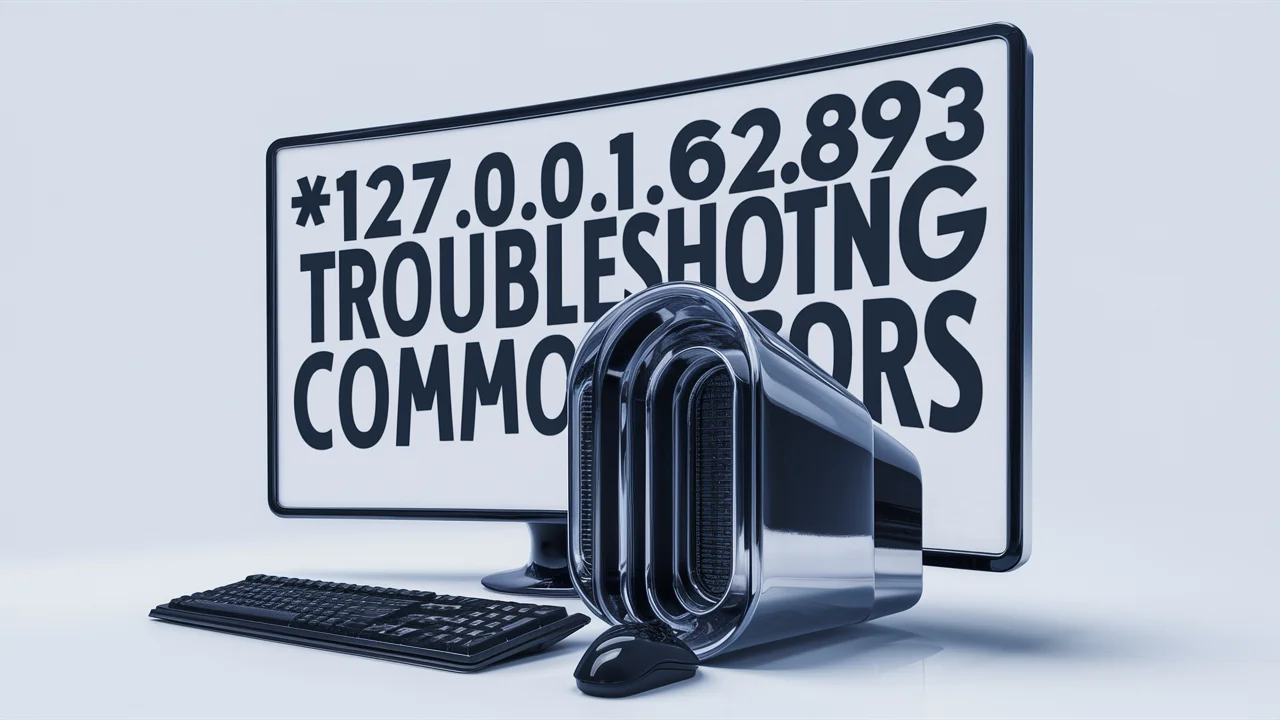When dealing with networking issues, encountering errors related to 127.0.0.1:62893 can be both confusing and frustrating. This particular combination—127.0.0.1 (the localhost IP address) and port 62893—often comes up in local development environments and network testing scenarios. Understanding why these issues arise and how to troubleshoot them effectively is crucial for anyone managing network configurations or developing applications that rely on local testing.
The localhost IP address 127.0.0.1 is widely used in various networking contexts, from web development to system diagnostics. It’s an essential part of any network administrator’s toolkit, but it can also lead to complex problems if not properly managed. Whether it’s a firewall blocking access to 127.0.0.1:62893, a service conflict, or a simple misconfiguration, the potential issues are varied and require careful attention.
In this article, we’ll explore:
- The significance of 127.0.0.1 and port 62893 in network setups.
- Common scenarios where problems occur.
- Step-by-step troubleshooting techniques to resolve these issues.
By the end of this guide, you’ll have a clear understanding of how to handle errors related to 127.0.0.1:62893 efficiently. Whether you’re a seasoned network administrator or someone relatively new to managing network configurations, these insights will help you navigate and resolve these errors with confidence.
Understanding 127.0.0.1 and Port 62893
What is 127.0.0.1?
The IP address 127.0.0.1 is commonly referred to as the localhost or loopback address. It’s a special address that always points to the device you’re currently using, regardless of the network you’re on. This means that any communication sent to 127.0.0.1 never leaves your machine; instead, it’s looped back to the source. Developers and system administrators use this address to test network software and configurations without needing an external network connection. For example, web developers might run a local web server on 127.0.0.1 to test their websites before making them public.
What is Port 62893?
Ports are virtual endpoints used by software applications to communicate over a network. Each port is identified by a number, ranging from 0 to 65535, with certain ranges reserved for specific types of traffic. Port 62893 is an example of a dynamically assigned or ephemeral port. These ports are often used temporarily by applications for specific tasks, such as establishing a connection between a client and a server. When an application on your computer needs to connect to another service, it might use port 62893 as part of this process.
Why 127.0.0.1 and Port 62893 Are Used Together
When 127.0.0.1 and port 62893 are used together, it’s usually within a local development or testing environment. For instance, a developer might configure a local web server to listen for connections on 127.0.0.1:62893. This setup ensures that the server is only accessible from the local machine, providing a safe environment for testing changes before deploying them to a live environment. Similarly, network administrators might use this combination to test services or diagnose issues without exposing their systems to external traffic.
Potential Issues with 127.0.0.1:62893
While 127.0.0.1 and port 62893 are useful tools, they can also lead to problems if not managed correctly. For example:
- Port conflicts can occur if another application is already using port 62893.
- Firewall settings might block access to 127.0.0.1:62893, preventing the intended communication.
- Misconfigurations in application settings can cause services to fail to start or function as expected.
Understanding these potential pitfalls is the first step in effective troubleshooting. In the next sections, we’ll explore common scenarios involving 127.0.0.1:62893 and provide detailed guidance on how to resolve these issues efficiently.
Common Scenarios Involving 127.0.0.1:62893
Scenario 1: Local Development Environment
In a local development environment, 127.0.0.1:62893 is often used to simulate how an application will behave in a real-world setting. Developers might configure a local server to listen on 127.0.0.1:62893 for testing purposes. For instance, a web developer could use this setup to run a local instance of a website, ensuring that all code changes work as expected before deployment. This setup allows the developer to make modifications without risking changes on a live server, which could disrupt service for users.
Common issues in this scenario include:
- Port conflicts: If another application is already using port 62893, the server may fail to start, or you might encounter an error indicating the port is in use.
- Firewall blocking: Firewalls can inadvertently block connections to 127.0.0.1:62893, especially if the port hasn’t been explicitly allowed in the firewall rules.
- Incorrect server configurations: Sometimes, the server might be incorrectly configured to listen on a different port, causing confusion when trying to connect to 127.0.0.1:62893.
Scenario 2: Testing Network Applications
Network administrators often use 127.0.0.1:62893 for testing network applications in a controlled environment. For example, they might simulate client-server communication by running both components on the same machine, using 127.0.0.1 to keep the traffic internal. This setup is valuable for testing software like databases, messaging queues, or custom-built network services. The internal loopback ensures that all data stays within the system, allowing for precise analysis and troubleshooting without external interference.
Potential issues in this scenario include:
- Connection failures: These can occur if the service isn’t properly bound to 127.0.0.1:62893 or if there’s a configuration error in the application.
- Security settings: Strict security policies might prevent the application from accessing 127.0.0.1:62893, leading to failed connections.
- Service dependencies: Sometimes, other services or dependencies required for the application to run on 127.0.0.1:62893 might not be available, causing the application to fail.
Scenario 3: Security Configurations
Security configurations can play a significant role in how 127.0.0.1:62893 is accessed and used. Network security protocols, such as firewalls and intrusion detection systems, might block or monitor traffic on this port. While this is often done to protect the system from unauthorized access, it can sometimes result in legitimate services being blocked. For example, a misconfigured firewall could block all traffic to 127.0.0.1:62893, leading to connectivity issues. Additionally, some security tools might flag traffic on 127.0.0.1:62893 as suspicious, especially if it deviates from typical patterns.
Issues related to security configurations include:
- Firewall rules: Improperly set firewall rules might prevent necessary traffic from reaching 127.0.0.1:62893.
- Intrusion detection: Systems might mistakenly flag internal traffic on 127.0.0.1:62893 as malicious, causing disruptions.
- Security policies: Overly strict security policies might block legitimate use of 127.0.0.1:62893, requiring adjustments to allow necessary traffic.
Understanding these common scenarios where 127.0.0.1:62893 is used can help you anticipate and resolve issues more effectively. Each of these situations presents unique challenges, but with the right approach, you can troubleshoot and fix problems related to 127.0.0.1:62893 efficiently. In the next section, we’ll dive into specific troubleshooting steps to help you resolve these issues.
Troubleshooting 127.0.0.1:62893 Errors
When encountering errors related to 127.0.0.1:62893, effective troubleshooting is key to resolving the issue quickly. This section outlines a step-by-step approach to diagnosing and fixing the most common problems associated with this localhost IP and port combination.
Step 1: Verify the Service Using the Port
The first step in troubleshooting is identifying which service or application is using port 62893. This can be done using several tools that are commonly available on most operating systems:
- Netstat Command: On Windows, Linux, or macOS, you can use the netstat command to display a list of active connections and the ports they are using. Run netstat -aon | findstr 62893 on Windows or netstat -anp | grep 62893 on Linux/macOS to find the service using port 62893.
- lsof Command: On Unix-like systems, the lsof -i :62893 command will list the process associated with port 62893. This helps pinpoint which application is utilizing the port, allowing you to troubleshoot further.
If you identify that a specific service is using port 62893, ensure that it is correctly configured and running as expected. If the service is misbehaving, restarting it or checking its configuration files for errors may resolve the issue.
Step 2: Check for Port Conflicts
Port conflicts occur when multiple services attempt to use the same port, leading to errors or unexpected behavior. If another service is already using port 62893, your application might fail to start or throw an error indicating that the port is unavailable. To resolve this:
- Identify Conflicting Services: Use the netstat or lsof commands mentioned above to see if another service is occupying port 62893.
- Change the Port: If a conflict is detected, consider changing the port number for one of the conflicting services. This can usually be done in the application’s configuration file by modifying the port parameter.
- Terminate the Conflicting Service: If the other service using port 62893 is not critical, you might choose to stop it to free up the port. Use the kill command on Unix-based systems or the Task Manager on Windows to terminate the process.
Step 3: Firewall and Security Settings
Firewalls play a crucial role in managing network traffic, but they can also inadvertently block necessary connections to 127.0.0.1:62893. To troubleshoot firewall-related issues:
- Check Firewall Rules: Review your firewall’s configuration to ensure that port 62893 is not being blocked. On Windows, you can do this through the Windows Defender Firewall settings. On Linux, use iptables or ufw to manage firewall rules.
- Add an Exception: If port 62893 is blocked, add an exception to allow traffic through the firewall. Be mindful of security implications, especially if the port is exposed to external networks.
- Test Connectivity: After adjusting the firewall settings, test the connection to 127.0.0.1:62893 to ensure that the issue is resolved.
Step 4: Review Application Configuration
Misconfigurations within the application using 127.0.0.1:62893 can also cause connection issues. It’s essential to review the application’s configuration settings to ensure they match the intended setup:
- Check Configuration Files: Look for configuration files in the application’s directory, which may include settings for the IP address and port. Ensure that the application is correctly set to use 127.0.0.1:62893.
- Look for Typographical Errors: Simple mistakes, such as a typo in the port number, can lead to connection issues. Double-check all relevant settings.
- Test Changes: After making adjustments, restart the application and test the connection to 127.0.0.1:62893 to confirm that the problem is fixed.
These steps provide a systematic approach to troubleshooting issues with 127.0.0.1:62893. Whether the problem lies in port conflicts, firewall settings, or application misconfigurations, following this guide should help you resolve the issue effectively. In the next section, we’ll cover advanced troubleshooting techniques for more complex scenarios.
Advanced Troubleshooting Techniques
When basic troubleshooting steps fail to resolve issues with 127.0.0.1:62893, more advanced techniques may be necessary. This section explores deeper diagnostic methods that can help uncover less obvious problems and fine-tune your network and application configurations.
Analyzing Logs for Errors
Log files are invaluable for diagnosing complex issues. Most services and applications generate logs that record events, errors, and other important information. By examining these logs, you can gain insight into what might be going wrong with 127.0.0.1:62893.
- Locate Relevant Logs: First, identify where the logs for your application or service are stored. Common locations include /var/log/ on Unix-like systems or specific log directories within the application’s folder on Windows.
- Search for Specific Errors: Use text search tools like grep on Linux or the built-in search functionality on Windows to find entries related to 127.0.0.1:62893. Look for keywords such as “error,” “failure,” or specific error codes that may indicate what’s going wrong.
- Interpret Log Entries: Understanding the context of log entries is key. Look at the events leading up to the error to identify potential causes. For instance, if you see repeated connection attempts followed by failures, this might indicate a network or configuration issue.
Using Network Diagnostic Tools
Network diagnostic tools provide a detailed view of what’s happening on your network, allowing you to analyze traffic, identify bottlenecks, and troubleshoot connectivity issues related to 127.0.0.1:62893.
- Wireshark: Wireshark is a powerful network protocol analyzer that lets you capture and inspect data packets on your network. You can filter the capture to focus on traffic related to 127.0.0.1:62893 and analyze the communication between your application and other services.
- Step-by-Step Guide:
- Start a capture in Wireshark.
- Apply a filter such as ip.addr == 127.0.0.1 && tcp.port == 62893 to focus on relevant traffic.
- Examine the captured packets for anomalies, such as failed connection attempts or unexpected data.
- Step-by-Step Guide:
- TCPdump: For a command-line alternative, tcpdump allows you to capture and analyze network traffic. Similar to Wireshark, you can filter for traffic on 127.0.0.1:62893 to pinpoint issues.
- Example Command: sudo tcpdump -i lo port 62893 captures traffic on the loopback interface specifically for port 62893.
- Traceroute: Although typically used for tracing the path to a remote host, traceroute can help identify issues within your local network setup, particularly if you suspect routing problems.
Reconfiguring Services for Optimal Performance
Sometimes, the issue with 127.0.0.1:62893 may not be a direct error but rather a performance problem. Poorly configured services can lead to slow connections, timeouts, or intermittent failures. Optimizing these configurations can resolve these issues.
- Optimizing Application Settings: Review the configuration settings of the application using 127.0.0.1:62893. Look for options related to timeouts, connection limits, or buffer sizes that might be contributing to performance issues.
- Example: Increasing the max_connections parameter in a database configuration can help if you’re hitting connection limits.
- Load Balancing: If the service is under heavy load, consider setting up load balancing to distribute traffic more evenly. While this is more common for remote servers, it can also apply to local environments if multiple services or processes are interacting with 127.0.0.1:62893.
- Resource Allocation: Ensure that your system has sufficient resources (CPU, memory, etc.) allocated to the services using 127.0.0.1:62893. Insufficient resources can lead to sluggish performance or dropped connections.
Case Study: Optimizing a Local Web Server
Imagine you’re running a local web server on 127.0.0.1:62893 for development purposes, and you notice that the server becomes unresponsive when handling multiple requests. By analyzing logs, you might find that the server is hitting connection limits or running out of memory. Using tools like Wireshark, you could observe that requests are being dropped, leading to timeouts.
In this scenario:
- Increasing the connection limit in the server’s configuration and allocating more memory to the service could resolve the issue.
- Fine-tuning the server settings for handling multiple connections efficiently ensures smoother performance and fewer errors.
These advanced troubleshooting techniques provide a deeper understanding of what might be causing issues with 127.0.0.1:62893. By analyzing logs, using network diagnostic tools, and optimizing service configurations, you can resolve even the most complex problems, ensuring your local environment runs smoothly. Next, we’ll discuss preventive measures to help avoid these issues in the future.
Preventive Measures and Best Practices
Preventing issues with 127.0.0.1:62893 is more efficient than troubleshooting them after they arise. By implementing best practices and preventive measures, you can minimize the risk of encountering problems in your local development or testing environment. This section covers strategies to help ensure that 127.0.0.1:62893 functions smoothly.
Regular System and Application Maintenance
Keeping your system and applications up to date is crucial for preventing issues related to 127.0.0.1:62893. Updates often include important security patches, bug fixes, and performance improvements that can help avoid potential problems.
- Operating System Updates: Regularly update your operating system to ensure that all network components, such as drivers and core services, are functioning optimally. This can prevent compatibility issues that might affect how 127.0.0.1:62893 operates.
- Application Updates: Ensure that all applications using 127.0.0.1:62893 are kept up to date. Developers frequently release updates to address bugs, improve performance, and enhance security, which can prevent errors.
- Service Restarts: Periodically restart services and applications that use 127.0.0.1:62893 to clear any lingering issues and ensure that configurations are applied correctly.
Effective Configuration Management
Proper configuration management is essential to avoid conflicts and misconfigurations that could lead to errors with 127.0.0.1:62893. Here are some best practices:
- Use Configuration Templates: If you manage multiple environments (e.g., development, testing, production), use configuration templates to ensure consistency across setups. Tools like Ansible, Puppet, or Chef can help automate and standardize configurations.
- Version Control: Store configuration files in a version control system like Git. This allows you to track changes, roll back to previous versions if issues arise, and ensure that all team members are working with the same configurations.
- Environment Isolation: Use containers (e.g., Docker) or virtual machines to isolate different environments. This prevents configuration conflicts and allows you to test changes in a controlled environment before applying them to your main setup.
Security Best Practices
Security configurations play a critical role in how 127.0.0.1:62893 is accessed and used. By following security best practices, you can protect your system while ensuring that legitimate traffic is not blocked.
- Firewall Management: Regularly review and update your firewall rules to ensure that port 62893 is accessible as needed. Implement a principle of least privilege, allowing only the necessary traffic while blocking everything else.
- Service Hardening: Apply security hardening techniques to the services using 127.0.0.1:62893. This includes disabling unnecessary features, using strong authentication methods, and encrypting sensitive data.
- Intrusion Detection: Implement intrusion detection systems (IDS) to monitor for suspicious activity related to 127.0.0.1:62893. This helps detect and respond to potential security threats in real-time.
Regular Monitoring and Alerts
Setting up monitoring and alerts for services using 127.0.0.1:62893 can help you catch and address issues before they escalate. This proactive approach ensures that you’re immediately informed of any anomalies.
- Monitoring Tools: Use monitoring tools like Nagios, Zabbix, or Prometheus to keep track of the performance and availability of services on 127.0.0.1:62893. These tools can alert you to issues such as high latency, connection failures, or resource exhaustion.
- Custom Alerts: Configure custom alerts to notify you when specific events occur, such as when a service fails to bind to port 62893 or when network traffic on 127.0.0.1:62893 exceeds expected levels.
- Log Monitoring: Implement log monitoring solutions that can automatically scan for errors related to 127.0.0.1:62893 and notify you when they occur. This allows you to respond quickly to issues, minimizing downtime.
Documentation and Knowledge Sharing
Maintaining clear documentation and encouraging knowledge sharing within your team can prevent issues from recurring and ensure that everyone knows how to handle problems with 127.0.0.1:62893 effectively.
- Comprehensive Documentation: Document all configurations, troubleshooting steps, and known issues related to 127.0.0.1:62893. This serves as a reference for team members and helps maintain consistency in managing these configurations.
- Team Training: Regularly train team members on best practices for managing 127.0.0.1:62893 and other network-related tasks. This ensures that everyone is equipped with the knowledge to prevent and troubleshoot issues.
- Post-Mortem Analysis: After resolving any major issues with 127.0.0.1:62893, conduct a post-mortem analysis to identify root causes and discuss what can be done to prevent similar issues in the future.
By implementing these preventive measures and best practices, you can significantly reduce the likelihood of encountering problems with 127.0.0.1:62893. In the next and final section, we’ll summarize key takeaways and provide final thoughts on managing and troubleshooting issues related to 127.0.0.1:62893.
Conclusion
Understanding and managing 127.0.0.1:62893 is crucial for anyone working in local development, network testing, or IT management. Throughout this guide, we’ve explored the various aspects of using 127.0.0.1:62893, from understanding its role in different scenarios to advanced troubleshooting techniques and preventive measures.
Key Takeaways:
- Understanding 127.0.0.1:62893: This IP address and port combination is typically used in local environments, serving as a loopback address that enables testing and development without involving external networks. It’s essential to grasp how and why it’s used to troubleshoot effectively.
- Common Scenarios and Issues: Whether you’re working in a local development environment, testing network applications, or dealing with security configurations, knowing the common scenarios where 127.0.0.1:62893 is used helps in anticipating and resolving issues. Common problems include port conflicts, firewall blocking, and misconfigured services.
- Troubleshooting Techniques: From verifying the service using the port to checking for port conflicts and reviewing firewall settings, systematic troubleshooting can resolve most issues. Advanced techniques like log analysis, network diagnostics, and service reconfiguration are valuable for tackling more complex problems.
- Preventive Measures: Regular maintenance, effective configuration management, and adherence to security best practices can prevent many of the issues related to 127.0.0.1:62893. Monitoring and documentation further support ongoing stability and quick resolution of any problems that do arise.
By applying the knowledge and techniques outlined in this article, you can confidently manage and troubleshoot issues related to 127.0.0.1:62893. Whether you’re developing an application, managing network security, or ensuring the smooth operation of local services, understanding the intricacies of 127.0.0.1:62893 is key to maintaining a reliable and efficient environment.
Final Thoughts:
Mastering 127.0.0.1:62893 isn’t just about fixing problems as they occur—it’s about proactive management, continuous learning, and applying best practices to minimize downtime and ensure your systems run smoothly. By staying informed and prepared, you can prevent many issues before they happen and quickly resolve those that do.
As you continue to work with 127.0.0.1:62893, remember that the strategies discussed here are not just one-time fixes but part of an ongoing process of improvement and optimization. With this guide, you’re well-equipped to handle any challenges that may come your way.

I’m Dariel Campbell, the guy who loves making your experience awesome at “San Antonio Vista.” Playing with stories and attractions is my thing. At San Antonio Vista, we’re here to make your visit stand out and shine. Let’s make your time in San Antonio unforgettable—come and join the fun at San Antonio Vista!
















